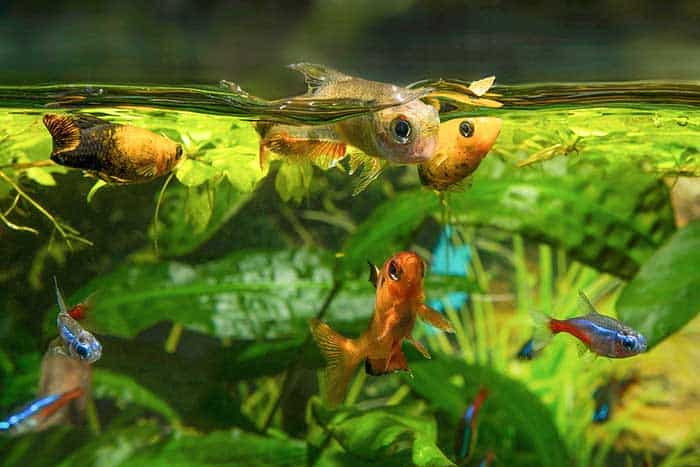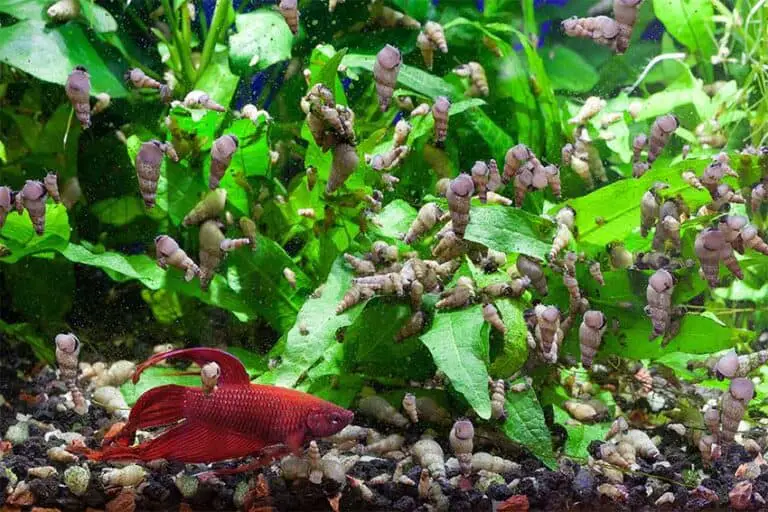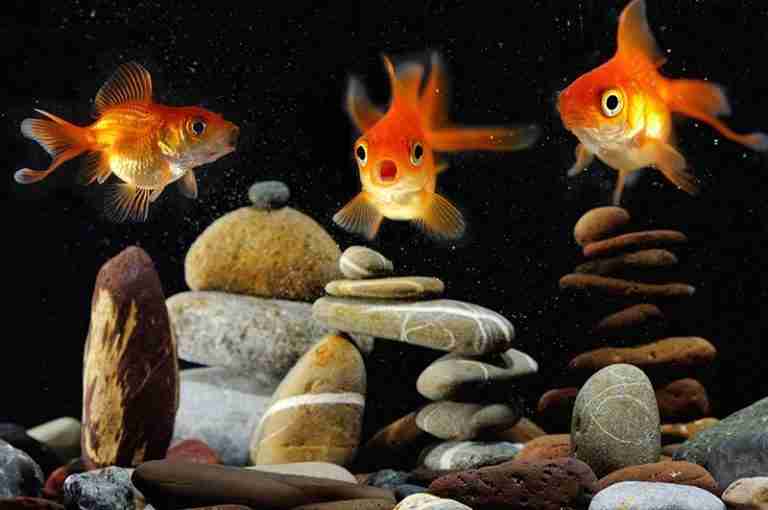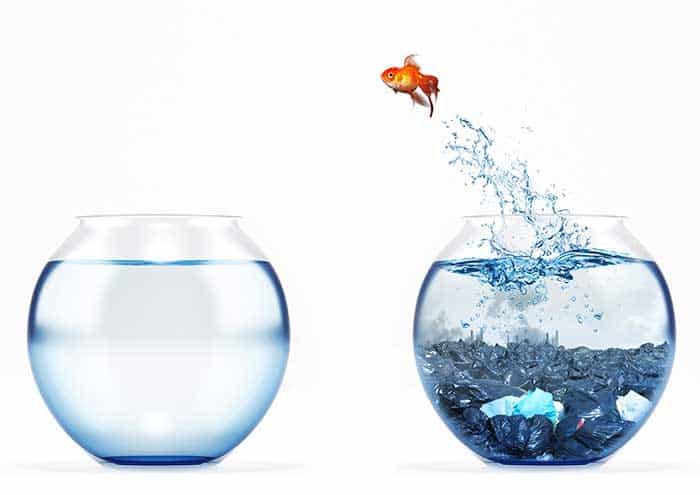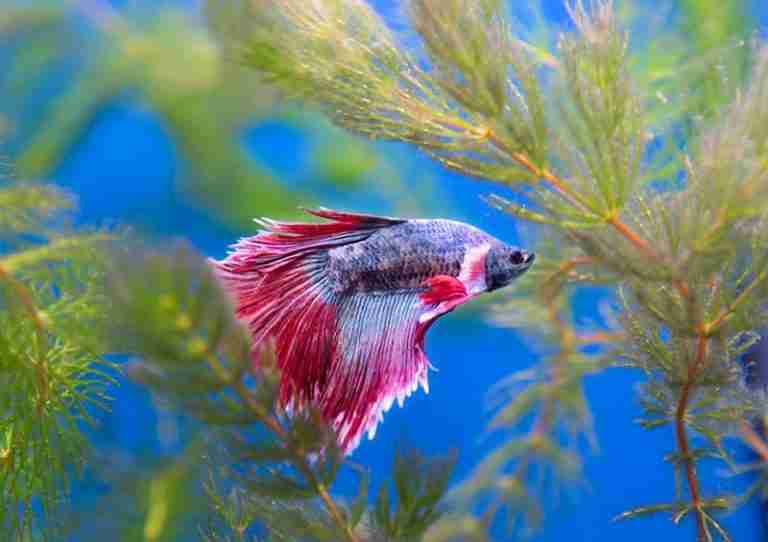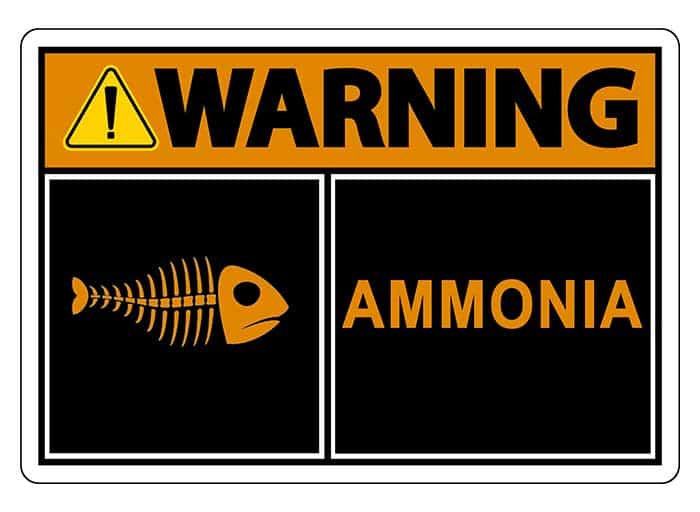How to soften aquarium water (Quick and easy tips)
Learning how to soften aquarium water is an excellent tool for fish keepers to have in their arsenal. Water softening can be achieved by either chemical or natural means, both of which are pretty accessible to the home aquarist.
Softening hard aquarium water can be done either by chemical means or naturally. Chemicals usually provide quick but short-lived results, whereas natural methods result in slower but longer-term results, which are often kinder to your fish.
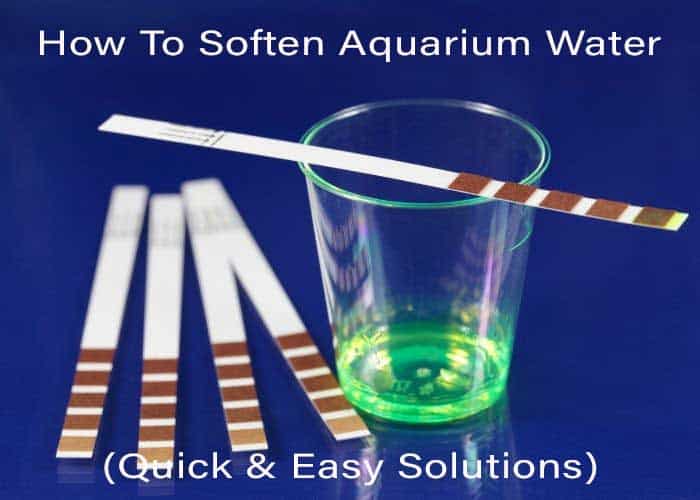
There are hundreds of ways to soften aquarium water, so this article will only cover the most effective and commonly used methods. I will also cover the basics of water hardness and what it means in an aquarium environment.
How to Soften Aquarium Water Effectively
The quickest ways to soften aquarium water are:
- Use commercial chemical solutions – Chemical water softeners are a quick and effective way to alter the hardness of your aquarium water. Commercial water treatments are specifically formulated not to harm your fish or plants. How quickly your water softens will depend on the solution you use and how often you dose it. Regular doses of chemical water softeners will consistently keep your aquarium at a lower hardness; however, these products have no lasting effect, so frequent dosing is necessary to maintain softened water.
- Reverse Osmosis – is a method whereby aquarium water is passed through a semi-permeable membrane that only allows pure water through, blocking all other impurities. Reverse osmosis is typically carried out using a device that pushes the water through the membrane under pressure. In short, this method provides a very neutral quality of water, similar to distilled water.
- Use distilled water – Removing some of the water in your tank and replacing it with distilled water will help to soften it. Distilled water is very pure and contains very little dissolved mineral content. Hard water generally contains an excess of dissolved minerals which usually gives it a higher (alkaline) pH, so by removing some of this water, you will be removing some of the mineral content.
- Use water softening pillows – Although not quite as speedy as the methods above, water softening pillows can help soften the water at a comfortable pace for your fish. A water-softening pillow is usually coated in an ionized resin that binds to the water’s soluble heavy metal ions and minerals and effectively removes them. Water softener pillows are most effective when placed inside your filter housing, where they can catch the minerals as the water passes through. (affiliate) link below.
How To Soften Aquarium Water Naturally
If you prefer to follow a more natural route to soften your aquarium water there are several options available to you which I cover below.
Use Rainwater In The Aquarium
If you have naturally hard water in your taps, use rainwater in your aquarium. Although you should always treat tap water before adding it to your aquarium, it can become expensive with frequent water changes.
Rainwater is naturally soft and can be collected from your guttering using a bucket. Even better, you can try collecting rainwater in a specifically designed container where it can be left to stand for a few days so that if any minerals are present, they will have time to evaporate.
Use Peat Moss
Peat moss is high in tannins and, when let loose, will aid in the natural softening of aquarium water. Peat moss is excellent at capturing the minerals present in hard water through “chelation,” a process that binds them together.
The mineral content of the water will be reduced as a result of chelation, making the water softer. Peat moss can be added to your tank and mixed with the substrate. You can also pre-treat water by adding it to a bucket of peat moss and letting it sit for a few days while it softens.
Softening aquarium water in this way can be a slow and gradual process that is less stressful to fish.
Schedule Regular Water Changes
Although obvious, this is often overlooked. Frequent water changes should be a regular part of your aquarium maintenance. Water changes naturally soften your water because you are removing the water containing minerals and heavy metals and replacing it with purer water that has been tested and treated satisfactorily.
Regular water changes will also avoid a build-up of ammonia, nitrate, and nitrite levels.
Add Some Driftwood To The Tank
Like peat moss, natural driftwood contains water-softening acidic tannins. It is vital to use natural driftwood that hasn’t been treated with chemicals that may harm your fish. Driftwood can be added to your aquarium as a feature while slowly reducing the hardness of your fish tank water.
Use Indian Almond Leaves
These leaves also have natural acid-inducing tannins and are often used for their medicinal benefits in fish. Simply adding a few of these leaves to your tank will gently bring down the alkalinity and KH (Carbonate Hardness) by neutralizing the buffering effects of carbonates and bicarbonates.
Aquarists widely use the methods above to soften their aquarium water which is a little too hard. Each method above is good at lowering aquarium water’s pH value (acid or alkaline). Later in this article, I will explain the relationship between water hardness and pH.
Recommended Product
Find The Best Price On Indian Almond Leaves At Amazon Or Chewy
What Is Water Hardness
You usually refer to the “General Hardness” (GH) when talking about water hardness, although this can be confused with the term “Carbonate Hardness” (KH), also referred to as “Total Alkalinity.”
General Hardness (GH)
Some water supplies have a high level of calcium and magnesium ions naturally present and are known as hard waters. In contrast, those with very low levels of calcium and magnesium ions are soft waters. General hardness is a measurement of magnesium and calcium ions in water and is measured by dGH (degree of general hardness).
A certain level of minerals in your water will benefit the overall health of your fish and other aquatic or plant life. Too many of these minerals can negatively affect other parameters within the water, such as its pH level, or cause an increase in ammonia, nitrates, or nitrites.
I only briefly discuss some aspects of pH in this article simply because it is related to a degree. However, if you want to gain a much better understanding of aquarium pH levels, you should read my other article: Fish Tank pH Levels (An easy guide for fishkeepers) which will cover everything you need to know.
Water hardness is also measured in ppm (parts per million). The relationship between ppm and GH will be better understood by looking at the table below.
| GH in dGH | GH in ppm | Water Hardness |
|---|---|---|
| 0-4 | 0-70 | Very Soft |
| 4-8 | 70-140 | Soft |
| 8-12 | 140-210 | Moderately Hard |
| 12-18 | 210-320 | Hard |
| 18-30 | 320-530 | Very Hard |
What Should The GH Level Be In A Fish Tank
Most freshwater aquariums should measure between 4-8 dGH or 70-140 ppm, which is comfortable for most fish species and usually reflects a healthy pH level. If your water becomes too soft, it can become prone to big swings in the level of acidity (pH).
Carbonate Hardness (KH)
Although they are related, carbonate hardness is an entirely separate measurement. Carbonate hardness measures the amount of carbonate and bicarbonate ions in the water, which affects its buffering capacity. Water buffers act as stabilizers, and KH is good at neutralizing acids, preventing large crashes in your pH level, which can harm aquatic life and plant life.
KH is measured on a similar scale to GH. The measurement for KH is dKH (degrees of KH) and is also measured in ppm (parts per million), and similar to GH, freshwater aquariums should typically sit at around 4-8 dKH (or 70-140 ppm).
Most tropical fish prefer neutral to soft water with slightly fewer minerals which they absorb through their skin. However, you will want to avoid your water from becoming too soft as this is generally more acidic (which can cause acid burns to your fish’s skin) and is generally more unstable.
Hard water fish species like African Cichlids or Paradise fish will require you to raise the GH and KH, which can be accomplished by adding commercial buffers or adding acid-neutralizing minerals such as limestone or crushed coral rock.
The opposite is true for softwater fish species such as dwarf cichlids, plecos, discus, and angelfish. It is a little more challenging to lower the GH due to the higher KH levels acting as a buffer against acids, but I have listed several methods above that should help.
If you want to learn more about alkalinity, I recommend you read my article: What Is Alkalinity In Aquariums (In simple terms).
Properties Of Hard Water
The more minerals and ions present in the water, the harder it is. Hard water contains more dissolved minerals than soft water, usually containing minerals found near the water source. Some areas have higher limestone, magnesium, and calcium levels, which dissolve into the water, causing it to become hard water.
Hard water has many more health benefits due to its higher mineral content, especially when drinking it. Fish and other living organisms will also benefit from the minerals contained in harder water, although there must be a balance when considering other water parameters such as pH.
The pH of hard water is usually higher and more alkaline (basic). If the water becomes too alkaline, this can harm your fish, often resulting in skin irritation and breathing issues. The same is true for softer water with a low pH indicating acidity. When water becomes too acidic, it can result in acid burns to a fish’s skin, lungs, and eyes.
Relationship Between pH, Alkalinity, And Hardness
How Does Water Become Hard
Water can become hard due to the dissolved minerals present in the water. Rocks and soils are examples of common substances that can dissolve into your local water supply, becoming part of it.
The climate is also a factor. Water seeping through limestone rocks will become increasingly hard because of the dissolved minerals present. As for which one has more influence, this depends on where you live.
Aquarium water can become hard over time due to the presence of certain mineral-rich ornaments, such as rocks rich in limestone or specific substrates rich in calcium or limestone.
Over time there can be a build-up of KH, which can be avoided by regularly changing your tank’s water and removing whatever is causing the problem.
How To Know If Your Aquarium Water Is Soft Or Hard
There are several ways to measure whether your water supply is soft or hard, and a simple test can be performed without requiring specialized equipment.
Pour some tap water into a glass. Now pour a little of the aquarium’s water into a glass and compare the two. It will be hard water if it is clear, whereas if your fish tank water is cloudy or milky, you most likely have soft water. Once you have established the type of tap water you have, any significant difference in the appearance of your aquarium will signal the opposite hardness.
Assuming that you use tap water to fill your tank, another way to find out if your aquarium water is soft or hard is to ask your local water company, as they should know the GH in each area they supply.
If you don’t want to ask your local water company, simply look at the taps in your house. People living in hard water areas often find limescale deposits or a chalky white substance around their taps, similar to the picture below.
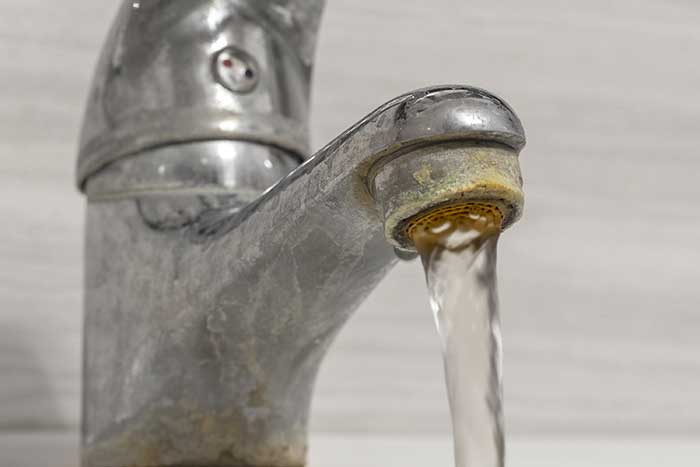
You should treat tap water to obtain the correct pH and GH before adding it to your tank, so you will need to measure these levels somehow. Even after you have added the water to your tank, calcium and magnesium levels have the potential to change, as can the number of carbonate and bicarbonate ions present.
Regular testing is the only easy way to keep your water parameters in check, and this is especially important in a newer tank until you find out how stable it is.
How Is Water Hardness Measured
Aquarium water hardness is easily measured using chemical test strips or digital meters. Unlike digital meters, the cheapest option is to use test strips, which will need replacing.
Test strips are also more convenient because they will usually have the capacity to test all of the necessary water parameters, whereas digital meters are generally only able to test one or two parameters.
How To Test Water Hardness In Aquarium Water
Test strip measurements are obtained by immersing into the aquarium water, waiting a specific amount of time, and then comparing the coloration changes on the test strip to a supplied color chart. Measurements are pretty accurate but are open to personal interpretation.
Digital meters are also dipped into the aquarium water and often provide an instant digital readout of the dKH or dGH. They may also return the measurement as ppm. Digital meters are pretty accurate. If you want to spend more money on a meter that can measure multiple parameters, they become very convenient and will pay for itself over time.
What I Use
I use test strips and an electronic meter, which can be found at the links below.
Find The Best Price For Tetra Easystrips 6 in 1 Freshwater/Saltwater Aquarium Test Strips.
Find The Best Price For a HydroTester Digital pH Meter And Thermometer.
Is Hard Water Bad For Fish
Hard water is not necessarily bad for fish and can benefit certain species, such as Goldfish and African Cichlids that come from naturally hard water environments.
Fish will adapt to the hardness of their environment if it does not change dramatically because they have evolved to withstand the conditions. However, sudden changes in water parameters due to a lack of precautions can be harmful or even fatal.
Can Hard Water Kill Fish
Hard water is not necessarily harmful to fish, but if your fish have become used to soft water and then moved to considerably harder water, they can experience osmotic shock, which can kill them.
The hardness of the water can dramatically impact the pH level of your water, and a pH that is too high or low can have a much more significant impact on the health of your fish.
Will Softening The Aquarium Water Harm My Fish
As I mentioned above, the water hardness is not a problem for fish, although changes to the hardness need to be gradual. Many fish won’t tolerate sudden changes to the water parameters and can quickly become stressed and ill.
If you are making sudden changes to water hardness or pH, you should remove your fish to another tank first, and when finished, you should gradually dilute the water into their holding tank until they become used to it.
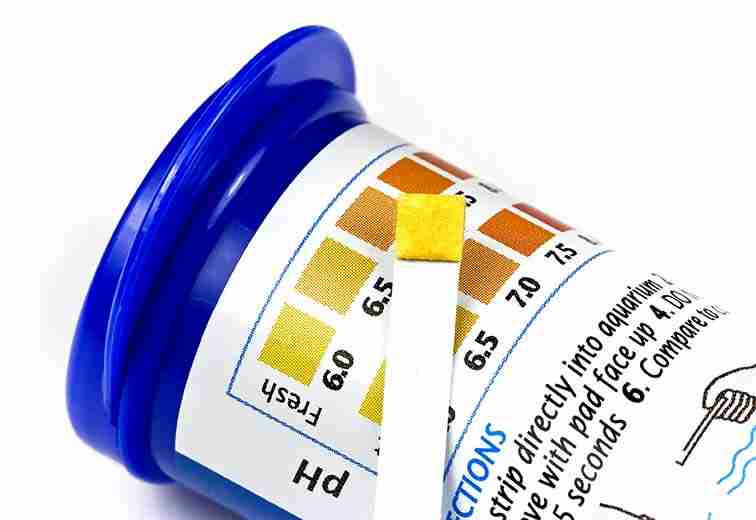
Risks And Benefits Of Soft Water In An Aquarium
Whether you have soft water in your taps or most of your fish prefer soft water, it would be wise to understand the risks and benefits of using it in an aquarium.
The main risks and drawbacks of soft water in an aquarium are:
- Soft water contains fewer healthy minerals – Fish need a wide range of minerals and trace elements to stay healthy, and soft water does not provide this, so you will have to give the necessary mineral through food.
- Soft water can cause frequent pH fluctuations – This is usually an issue with new tanks because the hardness of the tap affects the pH levels. Once the tank becomes established, the rocks and substrate’s hardness will counterbalance the tap water.
- Tank inhabitants will need extra care – The majority of tropical fish are used to living in soft water, but coldwater fish that come from hard water should be acclimatized slowly to prevent osmotic shock.
The main benefits of soft water in an aquarium are:
- Soft water holds more dissolved oxygen – Water containing fewer additives with a lower mineral content will hold more dissolved oxygen, making it easier for fish to breathe. An increase in oxygen levels will also increase the level of healthy bacteria, which break down food and fish waste.
- Fish and plants will absorb fewer toxins – Many chemicals in tap water, such as chlorine, fluoride, or unwanted minerals, can cause severe damage to fish and plants. Soft water can absorb these easily and cause ill health or death in fish.
- Fish will grow faster – While the effects on fish growth are still being debated, many people believe that softer water means more dissolved oxygen which means better food for fish, resulting in faster growth rates.
- Soft water is less prone to ammonia spikes – Excess ammonia can be caused by a build-up of waste and lead to decreased oxygen levels. Soft water is more acidic and capable of breaking down “ammonia-causing” waste.
- Reduced algae growth – Algae thrives in hard water conditions and is much less likely in soft water.
- Clearer Water – Most aquarists want to know how to get fish tank water crystal clear, and using soft water will definitely help. The lack of calcium and other minerals will reduce the haziness of the water.
When choosing your water hardness, you should keep it within a range suitable to all fish in your tank. You can research each fish to determine what water hardness they inhabit in the wild.
Conclusion
Water chemistry can be pretty complicated, and I have covered quite a lot in this article.
I have listed many methods of softening water and discussed the benefits and drawbacks of having a soft water tank.
Whether your water is soft or hard, most fish (unless they are a delicate, specialist species) will adapt to the water type they are kept in. Fish adapt better to gradual changes better than sudden changes, which can bring on osmotic shock.
The water type you use will play a role in the overall stability of the water chemistry, affecting pH, oxygen levels, and the nitrogen lifecycle.
Most freshwater aquariums benefit from a more neutral to slightly alkaline pH, which is obtained through neutral to a slightly harder GH level. However, assuming you won’t allow your water pH and GH to swing too far in either direction, you should be ok.
Once established, most aquariums find their own natural balance, and frequent water changes play an essential role in keeping them balanced.



